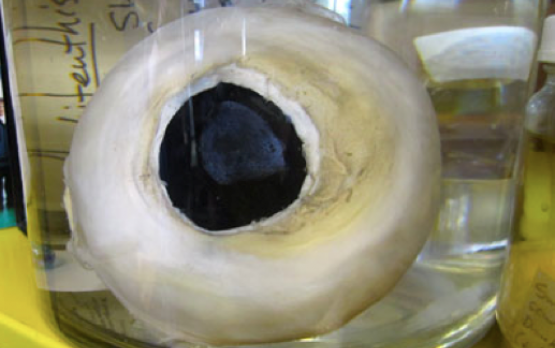The Biggest Eyes in the Animal Kingdom
August 20, 2012
By Mera McGrew
Researchers say that colossal squid (Mesonychoteuthis hamiltoni) have the largest eyes ever studied in the animal kingdom. Measuring 27cm (11in) in diameter, each eye is roughly the size of a soccer ball. “They are probably the largest eyes that have ever existed,” says Eric Warrant, a professor at the University of Lund in Sweden and an expert on animal vision.
Researchers say these huge eyes help the colossal squid survive and thrive in the depths of the Southern Ocean. Their eyes face forward, allowing them to properly judge distances. At great depths, where there is very little light, their large eyes also help them spot large animals, including predators like sperm whales.
Recently, Mission Blue caught up with Warrant to ask him more about his research and the massive eyes of the colossal squid.
At Lund University’s Department of Biology, Warrant pursues world-leading research that focuses on vision in dim light, primarily concentrating on deep-sea and nocturnal animals. In 2008, Warrant traveled to the Museum of New Zealand Te Papa in Wellington to take part in the dissection of a colossal squid and investigate the morphology of their eyes along with his friend and colleague Dan-Eric Nilsson.
Below is a cut version of a Q&A with Eric Warrant.
Why do colossal squid have such large eyes?
In order to spot sperm whales (their major enemy) at great depths in the sea where there is almost no daylight. Sperm whales trigger bioluminescence from the great density of tiny planktonic animals that they collide with while swimming. This light creates a bright aura around and behind the whale that can be seen at a great distance in the sea (about 120 m away), but only by an animal with an eye as large as that of the colossal squid.
In your opinion what is the most fascinating thing about the colossal squid’s eyes and why?
Their sheer size. They are probably the largest eyes that have ever existed, and the next largest eyes are only 9 cm in diameter (the eyes of a large swordfish). For most visual tasks – such as detecting objects illuminated in the faint downwelling daylight – an eye of greater than 9 cm isn’t justified on the basis of visual gains per unit energy cost. The only visual task that is an exception to this is the detection of large luminous objects – the major reason for the evolution of the giant eyes of squids. This evolution was necessary in order to give them an early warning visual alarm system for detecting sperm whales.
In 2008, you traveled to the Museum of New Zealand Te Papa in Willington to take part in the dissection of a colossal squid. Can you briefly describe what your role was within that dissection?
My role – together with my friend and colleague Dan-Eric Nilsson – was to investigate the morphology of the eyes of the squid to that level it was possible in an animal that had been frozen for over a year and then thawed-out.
Why was dissecting the colossal squid so important from a scientific standpoint?
Colossal squid are not uncommon in the deep ocean but our investigations of them are very few because they are so hard to see and to find. Most specimens that exist in museums are in very poor condition, having been found washed up on beaches in a half-rotten state. The eyes are usually in a particularly bad state. The New Zealand specimen had been caught alive on a long-line fishing vessel, dragged up onto the ship’s deck and then frozen immediately (I suspect that the ship’s crew recognized the scientific value in the specimen directly). Never before in the history of colossal squid research had so fine a specimen been obtained. Hence its enormous scientific value.
What did you and other researchers discover through the dissection?
I think this can be best answered by consulting Te Papa’s web site.
Top photo: Christine Dell’Amore. The eye pictured is not a colossal squid eye, it is a preserved giant squid eye.









“The New Zealand specimen had been caught alive on a long-line fishing vessel, dragged up onto the ship’s deck and then frozen immediately.”
How very cruel.